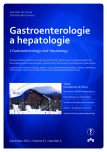Structure and function of the intestinal epithelial barrier
Authors:
P. Polák 1,2; J. Juránková 3,4; P. Husa 1,2
Authors‘ workplace:
LF MU Brno
1; Klinika infekčních chorob FN Brno
2; Katedra laboratorních metod LF MU Brno
3; Oddělení klinické mikrobiologie, FN Brno
4
Published in:
Gastroent Hepatol 2013; 67(6): 494-497
Category:
Clinical and Experimental Gastroenterology: Review Article
Overview
In recent years, there has been a revolutionary outbreak of our knowledge about ultra-/structure and function of the intestinal epithelial barrier. During evolution acquisited ability of the macroorganism to dynamically coordinate the interaction with the complexe colonizing microbial ecosystem has been recently shown to be crucial in the health and in the illness-prevention. As acute as chronic pathological conditions, primarilly infectious or non-infectious, may lead to disruption of the intestinal epithelial barrier. The presented overview summarises actual knowledge about structure and function of the intestinal epithelial barrier.
Key words:
intestinal epithelial barrier – tight junctions – infection
The authors declare they have no potential conflicts of interest concerning drugs, products, or services used in the study.
The Editorial Board declares that the manuscript met the ICMJE „uniform requirements“ for biomedical papers.
Submitted:
8. 8. 2013
Accepted:
18. 11. 2013
Sources
1. Selleri S, Palazzo M, Deola S et al. Induction of pro-inflammatory programs in enteroendocrine cells by the Toll-like receptor agonists flagellin and bacterial LPS. Int Immunol 2008; 20(8): 961–970.
2. Boroni Moreira AP, de Cássia Gonçalves Alfenas R. The influence of endotoxemia on the molecular mechanisms of insulin resistance. Nutr Hosp 2012; 27(2): 382–390.
3. Cho I, Blaser MJ. The human microbiome: at the interface of health and disease. Nat Rev Genet 2012; 13(4): 260–270.
4. Dethlefsen L, Relman DA. Incomplete recovery and individualized responses of the human distal gut microbiota to repeated antibiotic perturbation. Proc Natl Acad Sci USA 2011; 108 (Suppl 1): 4554–4561.
5. Korecka A, Arulampalam V. The gut microbiome: scourge, sentinel or spectator? J Oral Microbiol 2012; doi: 10.3402/jom.v4i0.9367.
6. Palmer C, Bik EM, DiGiulio DB et al. Development of the human infant intestinal microbiota. PLoS Biol 2007; 5(7): e177.
7. Clarke TB, Francella N, Huegel A et al. Invasive bacterial pathogens exploit TLR-mediated downregulation of tight junction components to facilitate translocation across the epithelium. Cell Host Microbe 2011; 9(5): 404–414.
8. O´Hara AM, Shanahan F. The gut flora as a forgotten organ. EMBO Rep 2006; 7(7): 688–693.
9. deFoneska A, Kaunitz JD. Gastroduodenal mucosal defense. Curr Opin Gastroenterol 2010; 26(6): 604–610.
10. Yu LC, Wang JT, Wei SC et al. Host-microbial interactions and regulation of intestinal epithelial barrier function: From physiology to pathology. World J Gastrointest Pathophysiol 2012; 3(1): 27–43.
11. Lata J, Juránková J. Střevní mikroflóra, slizniční bariéra a probiotika u některých interních chorob. Med Pro Prax 2012; 9(3): 106–112.
12. Tlaskalová H. Střevní imunitní systém a komensální bakterie. Medical tribune 2008; 4(11): A5.
13. Derikx JP, Luyer MD, Heineman E et al. Non-invasive markers of gut wall integrity in health and disease. World J Gastroenterol 2010; 16(42): 5272–5279.
14. Assimakopoulos SF, Papageorgiou I, Charonis A. Enterocytes’ tight junctions: From molecules to diseases. World J Gastrointest Pathophysiol 2011; 2(6): 123–137.
15. Vaziri ND, Goshtasbi N, Yuan J et al. Uremic plasma impairs barrier function and depletes the tight junction protein constituents of intestinal epithelium. Am J Nephrol 2012; 36(5): 438–443.
16. Hering NA, Fromm M, Schulzke JD. Determinants of colonic barrier function in inflammatory bowel disease and potential therapeutics. J Physiol 2012; 590(5): 1035–1044.
17. Baranwal S, Naydenov NG, Harris G et al. Nonredundant roles of cytoplasmic β- and γ-actin isoforms in regulation of epithelial apical junctions. Mol Biol Cell 2012; 23(18): 3542–3553.
18. Weber CR. Dynamic properties of the tight junction barier. Ann N Y Acad Sci 2012; 1257: 77–84.
19. Cunningham KE, Turner JR. Myosin light chain kinase: pulling the strings of epithelial tight junction function. Ann N Y Acad Sci 2012; 1258: 34–42.
20. Song DH, Lee JO. Sensing of microbial molecular patterns by Toll-like receptors. Immunol Rev 2012; 250(1): 216–229.
21. Scirocco A, Matarrese P, Petitta C et al. Exposure of Toll-like receptors 4 to bacterial lipopolysaccharide (LPS) impairs human colonic smooth muscle cell function. J Cell Physiol 2010; 223(2): 442–450.
22. Chan KL, Wong KF, Luk JM. Role of LPS/CD14/TLR4-mediated inflammation in necrotizing enterocolitis: pathogenesis and therapeutic implications. World J Gastroenterol 2009; 15(38): 4745–4752.
23. Fasano A. Zonulin and its regulation of intestinal barrier function: the biological door to inflammation, autoimmunity, and cancer. Physiol Rev 2011; 91(1): 151–175.
24. Pinzone MR, Celesia BM, Di Rosa M et al. Microbial translocation in chronic liver diseases. Int J Microbiol 2012; doi: 10.1155/2012/694629.
25. Al-Sadi R, Khatib K, Guo S et al. Occludin regulates macromolecule flux across the intestinal epithelial tight junction barrier. Am J Physiol Gastrointest Liver Physiol 2011; 300(6): G1054–G1064.
26. Wang F, Jiang H, Shi K et al. Gut bacterial translocation is associated with microinflammation in end-stage renal disease patients. Nephrology (Carlton) 2012; 17(8): 733–738.
Labels
Paediatric gastroenterology Gastroenterology and hepatology SurgeryArticle was published in
Gastroenterology and Hepatology

2013 Issue 6
- Metamizole vs. Tramadol in Postoperative Analgesia
- Metamizole at a Glance and in Practice – Effective Non-Opioid Analgesic for All Ages
- Possibilities of Using Metamizole in the Treatment of Acute Primary Headaches
- Current Insights into the Antispasmodic and Analgesic Effects of Metamizole on the Gastrointestinal Tract
- Spasmolytic Effect of Metamizole
Most read in this issue
- Diagnosis of disorders of gastric emptying in diabetic patients with diabetic autonomic neuropathy
- Endoscopic resolution of refractory postoperative bile leak from bile duct with fully covered self-expandable metallic stent
- Guidelines of the Czech gastroenterological society – endoscopic treatment of Barrett´s esophagus and early esophageal neoplasia
- Hepatocellular carcinoma – our experience with surveillance, effect and complications of transarterial chemoembolization
